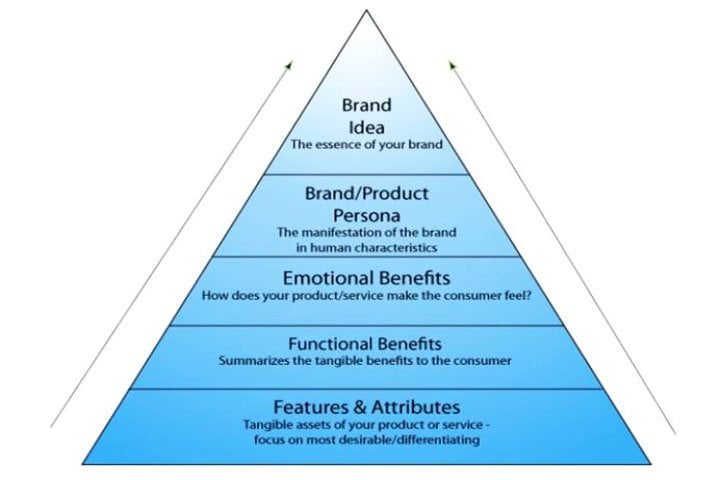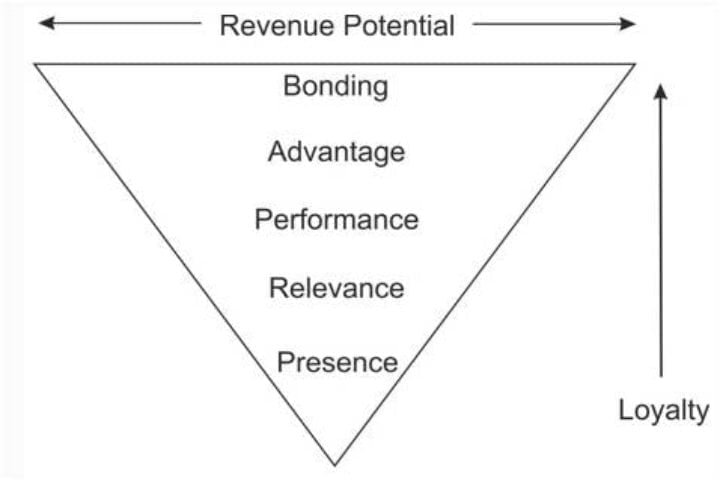The Brand Pyramid Concept
The Brand Pyramid is a strategic model that helps businesses build, strengthen, and effectively communicate their brand identity. Like a real pyramid, it comprises layers, each showing a different part of the brand.
In This Article
The model starts at the bottom and rises to the top, representing the path from first becoming aware of a brand to making strong emotional links with it, i.e. establishing loyalty to a particular brand.
Building a brand pyramid is a structured way of crafting a communication strategy that creates brand synergy, starting with the features and attributes of a product or service and ending with the “brand idea”.

The model can be visualized as an inverted pyramid with five levels. As one moves up the pyramid from the broad base to the narrow point, customer loyalty increases directly with revenue potential.

Five Levels to the Brand Pyramid
- Level One: Features and Attributes
- Level Two: Functional Benefits
- Level Three: Emotional Benefits
- Level Four: Brand Personality
- Level Five: Brand Idea
Level One: Features and Attributes
At level one, the focus is on identifying the unique characteristics of a product or service that are most desirable, and that set it apart from the competition.
For smartphone marketers, the attributes may include screen size, camera quality, battery life, and other specifications.

These are the features that potential customers initially consider when purchasing a smartphone. The base of the brand pyramid serves as the introduction, drawing people into the brand’s world.
Level Two: Functional Benefits
This level goes into more detail about the real benefits that people get from using a product or service. This is where brands move from saying “what” the product or service does to saying “how” it solves a problem or meets a need.
Continuing with the smartphone example, the functional benefits could include return on investment, cost savings through advanced features, time savings through increased productivity, and more. These benefits provide a practical reason for customers to choose your brand over others in the market.
A creative advertisement comparing the functional benefits of Google Pixel in comparison to the iPhone is worth watching.

Level Three: Emotional Benefits
The third level is about the intangible benefits consumers experience when engaging with the brand. In addition to being practical, these benefits touch on feelings and desires.

For instance, some emotional benefits for the smartphone brand could be happiness from capturing precious moments with the camera, confidence in the device’s reliability, time-saving due to its performance efficiency, and peace of mind from knowing that the device is secure and can be trusted. At this level, customers form an emotional connection with the brand.
Level Four: Brand Personality
The fourth level of the brand pyramid introduces the concept of brand personality. At this stage, the brand uses human characteristics that resonate with consumers emotionally. Brand personality is the bridge between the brand’s rational and emotional aspects. It manifests in human characteristics such as sincerity, competence, fun, etc.
Customers begin to see the brand as not just a product but as a companion that reflects their values and aspirations. Continuing with our previous example, consider the iPhone, which is a sincere companion for a photographer or content creator.

Level Five: Brand Idea
The “brand idea” is the essence of what a marketer wants their customers to think of every time they hear or see the brand. It’s the grand vision that encapsulates the entire brand experience and the emotional connection you’ve cultivated.
This VIVO phone advertisement urges you to switch off your phone and find greater joy in connecting with your loved ones. This advertisement actually hits a sweet spot and positions the brand as a responsible one who also cares about your well-being and relationships.

Although there are numerous variations of the brand pyramid, the majority are based on the one Millward Brown first developed in the mid-1990s. The pyramid illustrates the five key stages customers go through with a brand, starting with basic awareness and finishing with complete loyalty.
A brand pyramid may be developed as a marketing strategy for a product or service. The different stages of the brand pyramid help marketers understand what people go through while building loyalty to a brand. Incorporating the brand pyramid into a branding strategy can be a game-changer. With each passing level, a strong brand will be created that meets customers’ practical needs and fulfills their emotional desires, resulting in long-term loyalty and success.
Let us know your thoughts on the concept of brand pyramid in the comments…




